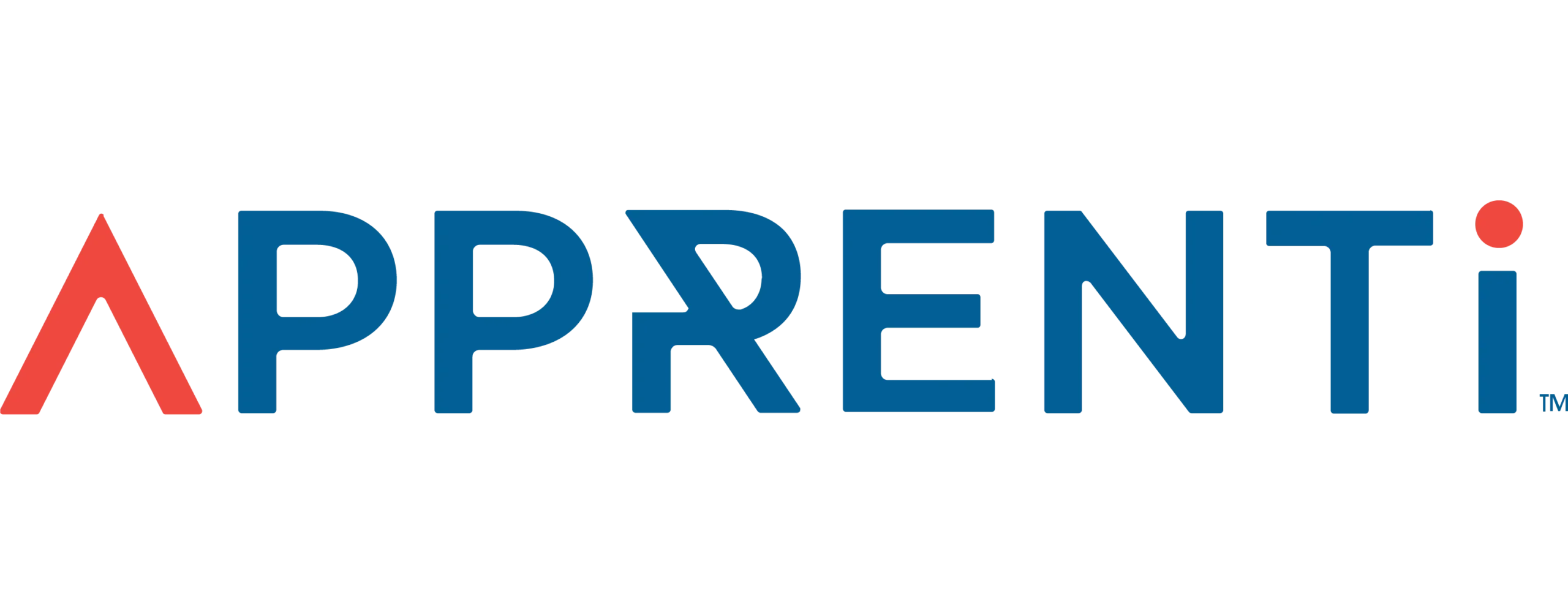Article Summary
- Evaluate your current apprenticeship processes to identify bottlenecks caused by manual systems like spreadsheets and emails.
- Use apprenticeship software to automate tracking, streamline compliance, and improve communication across all stakeholders.
- Enhance apprentice engagement and success by providing clear progress monitoring and accessible support tools through dedicated apprenticeship software.
- Leverage data insights from apprenticeship software to optimize program design, measure impact, and build a stronger talent pipeline.
- Adopt digital apprenticeship tools to standardize processes, ensure scalability, and stay competitive in workforce development.
Want to Learn More About Your Registered Apprenticeship Opportunities?
BOOK A FREE CONSULTATION
Why Modern Apprenticeships Need Apprenticeship Software?
Running multiple apprenticeship tracks is fantastic – you’re investing in talent and building your future workforce. But without apprenticeship software, managing it all with spreadsheets, endless email chains, and outdated systems gets complicated fast. As your programs grow, so does the challenge of keeping everything organized, compliant, and engaging.
See how spreadsheets slow growth
Spreadsheets were great… for the 90s. Today, using them to manage complex apprenticeship data – OJT hours, RTI progress, evaluations, compliance checks – is like trying to build a skyscraper with hand tools. It’s slow, prone to errors (typos happen!), and incredibly difficult to scale. As you add more apprentices or programs, the spreadsheet maze grows, making it nearly impossible to get a clear, real-time picture of anything. This manual tracking doesn’t just slow down administration; it actively hinders your ability to expand your valuable apprenticeship initiatives. Apprenticeship software replaces these outdated tools with streamlined, scalable systems that grow with your programs.
Calculate time wasted on emails
Think about the hours your team spends chasing down information via email. Sending reminders for OJT logs, requesting progress reports from mentors, coordinating with RTI providers, answering apprentice questions – it adds up. Each email chain is a separate silo of information, easily lost or overlooked. This constant back-and-forth drains productivity that could be spent on mentoring, program improvement, or strategic planning. It’s not just inefficient; it’s frustrating for everyone involved. With apprenticeship software, communication is centralized, tracked, and simplified—freeing up valuable time and reducing confusion.

Discover compliance risks
Compliance isn’t optional, it’s essential. Manually tracking Department of Labor requirements, state regulations, and internal standards across multiple spreadsheets and documents is a high-risk game. Missing a deadline, incorrect hour logging, or inconsistent documentation can lead to failed audits, loss of funding, and damage to your program’s reputation. Relying on manual checks leaves too much room for human error. Without a centralized, automated system, ensuring consistent compliance across all apprentices and programs is a constant uphill battle.
Learn about automation benefits
Imagine a world where OJT hours are logged digitally, progress reports are automatically generated, compliance alerts are proactively displayed, and communication occurs in a single central hub. That’s the power of automation through dedicated apprenticeship software. It frees up your HR team, mentors, and administrators from tedious manual tasks, allowing them to focus on high-value activities like coaching and program development. Automation brings efficiency, accuracy, and peace of mind.
Pro tip: Start by auditing the time your team currently spends on manual apprenticeship administration tasks. Quantifying the lost hours often highlights the immediate ROI of adopting dedicated software.
Let’s Talk About Making Program Management Simple
Okay, so we know the manual methods are clunky. But what does simpler actually look like day-to-day? It means less juggling and more clarity. It means having all the moving parts – employers, sponsors (if applicable), schools, mentors, and apprentices – connected and communicating effectively within a single system. Think of it as upgrading from a tangled box of wires to a sleek, integrated circuit board for your apprenticeship programs.

Coordinate multiple stakeholders efficiently
Apprenticeships are a team sport, right? You’ve got the apprentice, their direct manager or journeyworker, maybe an external sponsor, the RTI provider, and your internal HR team. Keeping everyone informed and aligned using separate tools is a recipe for miscommunication. A dedicated platform acts as a central hub where:
- Sponsors can oversee program progress.
- Employers can track work performance and OJT.
- RTI providers can update related training completion.
- Journeyworkers can easily provide feedback.
- Apprentices can see their entire roadmap. This unified view ensures everyone is working with the same information, reducing confusion and saving time.
Track progress automatically
Forget chasing down log submissions or manually compiling reports. Apprenticeship software allows for real-time tracking of both On-the-Job Training (OJT) hours and Related Technical Instruction (RTI). Apprentices and mentors can log hours digitally (often via a mobile app), and the system automatically aggregates this data. You get instant visibility into who’s on track, who’s falling behind, and where potential issues might be arising. This automation is key for timely interventions and accurate record-keeping.
Streamline communication channels
Reduce the reliance on scattered emails and phone calls. A good platform centralizes communication. Need to send an update to all apprentices in a specific track? Easy. Need to check in with a mentor about an apprentice’s progress? Do it right in the system. This creates a documented, easily searchable history of communication related to each apprentice’s journey. It fosters a more connected and responsive environment for everyone.
Pro tip: Look for software that offers role-based dashboards. This ensures each stakeholder sees the information most relevant to them, reducing noise and improving focus.
Here’s How to Boost Apprentice Success
Ultimately, the goal of any apprenticeship program is to develop skilled, engaged employees who stick around. Clunky management processes don’t just frustrate administrators; they can negatively impact the apprentice experience. Providing apprentices with clear expectations, consistent feedback, and easy ways to track their own progress is crucial for their motivation and success. This is where the right tools make a huge difference, transforming the experience from confusing to empowering.
Monitor individual progress clearly with apprenticeship software
Apprentices thrive when they know where they stand and what’s next. Instead of relying on occasional check-ins or deciphering complex spreadsheets, dedicated software provides a clear, visual roadmap. Apprentices can see:
- Completed OJT hours vs. required hours.
- RTI course progress and grades.
- Competencies mastered and those still outstanding.
- Feedback from mentors and supervisors. This transparency empowers apprentices to take ownership of their learning journey. For managers, it makes identifying support needs much faster.
Support skill development effectively
Modern apprenticeship software goes beyond simple hour tracking. It allows you to map specific competencies to OJT tasks and RTI courses. This ensures apprentices aren’t just logging time, but demonstrably building the skills you need. Mentors can provide targeted feedback directly linked to these competencies. Some platforms even allow for uploading evidence of work, creating a rich portfolio of the apprentice’s capabilities. You might even consider enhancing your programs with custom-built training modules; GoSprout’s Course Development service helps employers create tailored content to meet specific skill needs.
Create accountability systems
Clear expectations and easy tracking naturally foster accountability. When apprentices can easily see their progress against program requirements, and know that their mentors and administrators can too, they are more likely to stay on top of their responsibilities. Automated reminders for logging hours or completing assignments also help keep everyone on track without constant manual nagging. This structured accountability helps build professional habits.
Build engagement pathways
An engaged apprentice is a successful apprentice. Software can boost engagement by making the program interactive and accessible. Features like mobile access mean apprentices can log hours or check progress anytime, anywhere. Centralized communication keeps them connected to their support network. Feeling like part of a well-organized, supportive program significantly boosts morale and commitment. Consider exploring why apprenticeships are such a powerful model for workforce development when supported by the right infrastructure.
Pro tip: Use the data from the software to celebrate milestones with apprentices. Recognizing progress publicly reinforces positive behavior and boosts motivation.
Let’s Build Your Dream Workforce

Apprenticeships are a strategic investment in your company’s future talent. But are your current processes truly setting you up for long-term success? Moving beyond manual methods allows you to be more intentional and data-driven in how you design, manage, and grow your programs. It’s about shifting from reactive problem-solving to proactive workforce planning, ensuring your apprenticeships directly address your skills gaps and business goals.
Design scalable training programs
Manual systems inherently limit scalability. What works for 10 apprentices breaks down for 50 or 100. Apprenticeship software provides the framework to easily replicate and manage multiple programs across different departments or locations. Standardized workflows, templates for OJT and RTI, and centralized oversight make expansion manageable, not chaotic. This scalability is crucial for meeting evolving business needs and truly leveraging apprenticeships as a core talent strategy. If you’re unsure how to structure these programs for growth or navigate funding opportunities, exploring options like Workforce Planning & Consulting can provide expert guidance to align your apprenticeship strategy with business objectives and potential financial incentives.
Attract ideal candidates
A well-managed, tech-enabled apprenticeship program is a powerful recruitment tool. It signals to potential apprentices (especially younger, tech-savvy generations) that your company is organized, modern, and invested in their development. Highlighting the use of dedicated software with features like mobile access and clear progress tracking can be a key differentiator in attracting top talent compared to programs relying on outdated methods. It shows you value their experience.
Measure program impact
How do you really know if your apprenticeships are delivering ROI? Manual tracking makes it incredibly difficult to gather and analyze meaningful data. Apprenticeship software provides dashboards and reporting features that allow you to track key metrics like:
- Completion rates
- Skill attainment progress
- Time-to-proficiency
- Post-apprenticeship retention [1]
- Program costs vs. benefits This data is invaluable for demonstrating program value to leadership, identifying areas for improvement, and making informed decisions about future workforce investments. You can find more insights on the differences and benefits by comparing apprenticeships vs. internships.
Pro tip: Define your key performance indicators (KPIs) for program success before implementing software. This ensures you configure the system to track the data that matters most to your business goals.
Here’s What Top Programs Do Differently
Leading apprenticeship programs aren’t just winging it. They leverage technology to create efficient, effective, and engaging experiences for everyone involved. They’ve moved past the limitations of manual processes and embraced tools that provide visibility, consistency, and data-driven insights. Adopting apprenticeship software isn’t just about catching up; it’s about implementing the best practices that define high-impact workforce development initiatives.
Implement data-driven decisions
Top programs don’t rely on gut feelings. They use the data captured by their apprenticeship software to continuously improve. Are apprentices struggling with a particular module? The data will show it. Is one mentor’s group progressing faster than others? The system highlights it. This data allows for targeted interventions, curriculum adjustments, and resource allocation based on evidence, not anecdotes. The GoSprout Apprenticeship Management Platform is designed specifically for this, uniting stakeholders on a cloud-based system to simplify tracking OJT, RTI, and compliance, turning data into actionable insights.
Standardize success metrics
Consistency is key, especially when managing multiple programs or locations. Leading programs use software to establish and track standardized metrics for success across the board. This ensures fairness, allows for meaningful comparisons between different cohorts or tracks, and simplifies reporting to stakeholders (including regulatory bodies). Everyone understands what success looks like and how it’s measured.
Enable mobile learning
Today’s workforce is mobile, and apprentices are no exception. Providing access to program information, OJT logging, and communication tools via a dedicated mobile app dramatically improves accessibility and engagement. Apprentices can track their progress on the go, submit logs from the job site, and stay connected without being tied to a desktop. The GoSprout Apprentice App puts everything an apprentice needs right in their pocket, enhancing their ability to manage their training effectively.
Foster stakeholder collaboration
We’ve said it before: apprenticeships are a team effort. The best programs use technology to break down silos and foster seamless collaboration between employers, mentors, RTI providers, sponsors, and apprentices. Centralized communication, shared dashboards, and automated notifications keep everyone on the same page, working together towards the common goal of apprentice success. You can connect with other organizations involved in apprenticeships through platforms like LinkedIn.
Pro tip: Regularly review your program data with all key stakeholders. Collaborative analysis fosters shared ownership and leads to more effective program adjustments.
Conclusion: Why Your Company Needs to Digitize Apprenticeships Now
Look, continuing to manage your valuable apprenticeship programs with outdated, manual systems isn’t sustainable. It creates unnecessary administrative burdens, increases compliance risks, hinders scalability, and can even detract from the apprentice experience. Embracing dedicated apprenticeship software isn’t just about efficiency; it’s a strategic move to maximize the return on your workforce development investment.
By adopting a platform like GoSprout, you simplify complexity, empower your apprentices with clear roadmaps and mobile tools, provide administrators and mentors with the visibility they need, and gain crucial data insights to continuously improve. It’s about future-proofing your talent pipeline and ensuring your programs deliver the skilled, dedicated employees your company needs to thrive. Let’s connect and explore how we can make your apprenticeship management simpler and more impactful.
Frequently Asked Questions
- Q: We already have internal systems. Why switch?
- A: While internal systems might handle pieces, dedicated apprenticeship software integrates OJT, RTI, compliance, communication, and reporting specifically for apprenticeship needs, reducing manual workarounds and providing holistic program visibility that generic HR or project tools lack.
- Q: Is implementing new software difficult and time-consuming?
- A: Modern apprenticeship platforms are designed for usability. GoSprout, for example, focuses on a simple setup process and provides support to get your programs migrated and your team trained efficiently, minimizing disruption.
- Q: Can apprenticeship software handle different types of programs and trades?
- A: Yes, flexible platforms like GoSprout are designed to accommodate various apprenticeship standards, trades, and program structures. You can configure OJT tracking, competencies, and RTI requirements to match your specific needs.
- Q: How does this software help with compliance reporting?
- A: By centralizing all data (hours, progress, evaluations), the software can often generate reports formatted for regulatory bodies like the Department of Labor, significantly simplifying audit preparation and reducing the risk of errors associated with manual compilation.
- Q: What’s the ROI of investing in apprenticeship software?
- A: ROI comes from multiple areas: reduced administrative time, improved compliance (avoiding penalties), increased apprentice retention [1], faster time-to-proficiency, and better data for program optimization, ultimately leading to a more effective talent pipeline.
References
- Springer. Case Study: Automation Education and Qualification Apprenticeships. https://link.springer.com/chapter/10.1007/978-3-030-96729-1_68
- Urban Institute. What Works in Tech Apprenticeship. https://www.jstor.org/stable/pdf/resrep67057.pdf?acceptTC=true&coverpage=false&addFooter=false
- McKinsey. The gen AI skills revolution: Rethinking your talent strategy. https://www.mckinsey.com/capabilities/mckinsey-digital/our-insights/the-gen-ai-skills-revolution-rethinking-your-talent-strategy
- New York Times. A.I. Is Prompting an Evolution, Not an Extinction, for Coders. https://www.nytimes.com/2025/02/20/business/ai-coding-software-engineers.html
- Medium. Book Review: Apprenticeship Patterns — Guidance for the Aspiring …. https://robertdelwood.medium.com/book-review-apprenticeship-patterns-guidance-for-the-aspiring-software-craftsman-808c95ee478e
- Access Creative College. 8 Ways an Apprentice Can Benefit a Software Development Company. https://www.accesscreative.ac.uk/blog/8-ways-an-apprentice-can-benefit-a-software-development-company/
- Wikipedia. Posit PBC. https://en.wikipedia.org/wiki/Posit_PBC
- Wikipedia. Beto O’Rourke. https://en.wikipedia.org/wiki/Beto_O’Rourke















